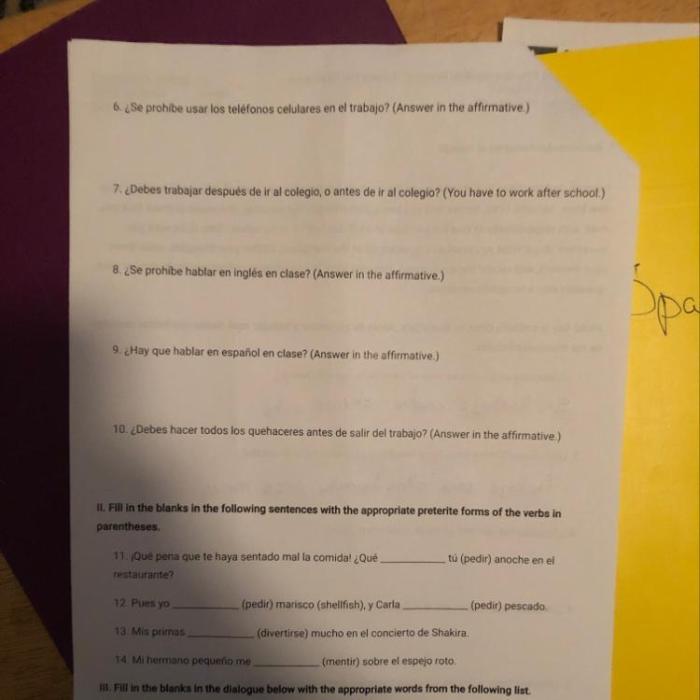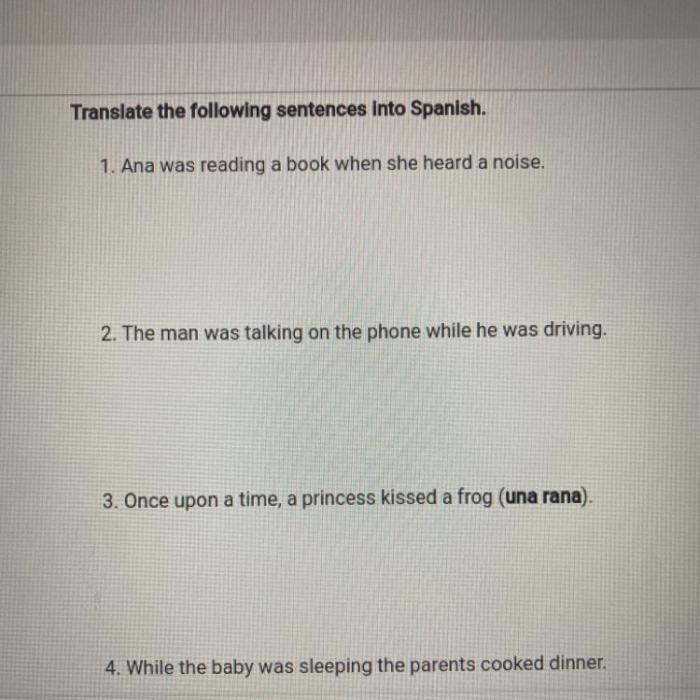Embark on a captivating journey with the Spanish 2 Semester 2 Review, a comprehensive guide designed to reinforce your knowledge and propel your Spanish proficiency to new heights.
This review encompasses a thorough examination of vocabulary, grammar, culture, communication skills, and literature, providing a holistic understanding of the Spanish language and its rich cultural context.
Vocabulary Review: Spanish 2 Semester 2 Review
The vocabulary covered in Semester 2 is extensive, encompassing a wide range of themes and topics. These words are essential for expanding your Spanish vocabulary and enhancing your communication skills.
To facilitate your review, we have categorized the vocabulary into several s, each focusing on a specific aspect of the language. Within each , you will find a comprehensive list of vocabulary words, along with their definitions, pronunciations, and example sentences.
Daily Routine
- Despertarse(to wake up) – Pronunciation: [des-per-tar-se] – Example: Me despierto a las 7 de la mañana.(I wake up at 7 in the morning.)
- Lavarse los dientes(to brush one’s teeth) – Pronunciation: [la-var-se los djen-tes] – Example: Me lavo los dientes dos veces al día.(I brush my teeth twice a day.)
- Desayunar(to have breakfast) – Pronunciation: [de-sa-yu-nar] – Example: Desayuno cereal con leche.(I have cereal with milk for breakfast.)
Grammar Review
In Semester 2, we delved into the intricacies of Spanish grammar, exploring various concepts that enhance our understanding and fluency in the language. From mastering verb tenses to understanding the nuances of pronouns, we have covered a wide range of topics that will serve as a solid foundation for your continued Spanish language journey.
Present Perfect Tense
The present perfect tense (el pretérito perfecto) is used to describe actions or events that started in the past and continue into the present or have just been completed. It is formed by combining the present tense of the verb haber (to have) with the past participle of the main verb.
- Example: He habladocon mi profesor. (I have spoken with my teacher.)
- Example: Hemos comidoen un restaurante. (We have eaten in a restaurant.)
Past Imperfect Tense
The past imperfect tense (el pretérito imperfecto) is used to describe ongoing or habitual actions in the past. It is formed by adding the appropriate endings to the stem of the verb.
- Example: Estudiabamucho cuando era estudiante. (I used to study a lot when I was a student.)
- Example: Vivíanen una casa grande. (They lived in a big house.)
Indirect Object Pronouns, Spanish 2 semester 2 review
Indirect object pronouns replace indirect objects, which are typically people or things that receive the action of the verb. They come before the verb and agree in number and person with the indirect object.
- Example: Ledoy un regalo a mi madre. (I give my mother a gift.)
- Example: Lesescribo una carta a mis amigos. (I write a letter to my friends.)
Direct Object Pronouns
Direct object pronouns replace direct objects, which are typically people or things that are directly affected by the action of the verb. They come before the verb and agree in number and person with the direct object.
As we wrap up our Spanish 2 semester 2 review, it’s helpful to delve into the historical context of the civilizations we’ve studied. Check out this mayans aztecs and incas map to visualize their geographical locations. Understanding their territories enriches our comprehension of their cultures, beliefs, and the linguistic influences that shaped the Spanish language.
- Example: Laveo todos los días. (I see her every day.)
- Example: Losconozco bien. (I know them well.)
Reflexive Pronouns
Reflexive pronouns are used when the subject of a verb performs an action on themselves. They come before the verb and agree in number and person with the subject.
- Example: Melavo las manos. (I wash my hands.)
- Example: Secepillan los dientes. (They brush their teeth.)
Cultural Review

In Semester 2, we delved into the vibrant and diverse cultures of Spanish-speaking countries. From the bustling streets of Madrid to the picturesque beaches of the Caribbean, we explored customs, traditions, and social norms that shape the daily lives of Spanish speakers.
One of the most striking cultural aspects is the importance of family and community. In many Spanish-speaking countries, extended families live together or in close proximity, and family bonds are incredibly strong. Respect for elders is highly valued, and grandparents often play a central role in family life.
Social Customs
- Greetings:In Spanish-speaking cultures, greetings are warm and often involve physical contact. A handshake or a kiss on the cheek (known as a “beso”) is common among friends and acquaintances.
- Dining Etiquette:Mealtimes are important social occasions in Spanish-speaking countries. It is customary to arrive on time for meals and to engage in conversation during the meal. Sharing food and drinks is a sign of friendship and hospitality.
- Siesta:In many Spanish-speaking countries, a midday break known as “siesta” is taken to rest and recharge. Shops and businesses may close during this time, and people often retreat to their homes for a nap or quiet time.
Traditions and Festivals
- Flamenco:This passionate dance form, originating in Andalusia, Spain, combines rhythmic footwork, expressive body movements, and soulful singing.
- La Tomatina:Held annually in the town of Buñol, Spain, this festival involves a massive tomato fight where participants throw tomatoes at each other.
- Day of the Dead:Celebrated in Mexico and other Latin American countries, this festival honors deceased loved ones with offerings of food, drinks, and flowers.
Social Norms
- Respect for Authority:In Spanish-speaking cultures, there is a strong sense of respect for authority figures, including parents, teachers, and government officials.
- Machismo:In some Spanish-speaking societies, traditional gender roles still prevail, with men being expected to be strong and dominant while women are expected to be more submissive.
- Personalismo:Spanish speakers often prioritize personal relationships over formal rules or procedures, and they value building strong bonds with others.
Communication Skills

Assessing the progress made in developing Spanish communication skills is crucial. Students have been evaluated based on their speaking, listening, reading, and writing abilities. This feedback aims to highlight strengths and areas for improvement, providing guidance for further practice and enhancement.
Speaking
Students have demonstrated commendable progress in their speaking abilities. They can engage in basic conversations, expressing their thoughts and ideas with increasing clarity and confidence. Their pronunciation has improved significantly, allowing them to communicate more effectively. However, further practice in expanding vocabulary and refining grammar is encouraged to enhance fluency and accuracy.
Listening
Listening comprehension has also shown improvement. Students can now follow conversations and extract key information from audio sources. They are able to identify main ideas, supporting details, and cultural references. Continued exposure to authentic Spanish materials, such as podcasts or videos, will further enhance their listening skills and cultural understanding.
Reading
Reading comprehension has progressed steadily. Students can understand written texts, grasping the main ideas and supporting arguments. They are developing the ability to analyze and interpret different text types, including articles, stories, and poems. Encouraging regular reading and exposure to diverse literary works will continue to expand their vocabulary and improve their reading fluency.
Writing
Writing skills have also improved. Students can write clear and coherent sentences, expressing their ideas in a structured manner. They are able to use appropriate grammar and vocabulary, demonstrating an understanding of sentence structure and verb conjugation. Continued practice in writing various text types, such as essays, narratives, and emails, will further enhance their writing proficiency.
Literature Review

In Semester 2, we delved into a diverse range of literary works, each offering unique perspectives and insights into human nature and society. These texts showcased a variety of literary devices, explored profound themes, and introduced memorable characters.
Through the analysis of these works, we gained a deeper understanding of the author’s intentions, style, and purpose. We explored the complexities of character development, the significance of plot structure, and the impact of literary devices on the overall narrative.
Themes
The literary works we studied explored a wide range of themes, including:
- Love and relationships
- Identity and belonging
- Social justice and inequality
- The nature of good and evil
Characters
The characters in these works were complex and multifaceted, each with their own motivations, desires, and flaws. We analyzed the development of these characters over the course of the narrative, examining how their experiences shaped their actions and beliefs.
Plot Development
The plots of the works we studied were carefully crafted to engage and intrigue the reader. We examined the structure of these plots, including the exposition, rising action, climax, falling action, and resolution. We also discussed the use of foreshadowing, suspense, and other literary devices to create tension and build towards a satisfying conclusion.
Literary Devices
The authors of the works we studied employed a variety of literary devices to enhance the narrative and convey their message. We analyzed the use of:
- Similes and metaphors
- Foreshadowing and symbolism
- Irony and allegory
Author’s Style and Purpose
The authors of the works we studied each had their own unique style and purpose. We examined the use of language, imagery, and structure to create a distinct voice and convey a particular message. We also discussed the historical and cultural context in which these works were written, as this often influenced the author’s perspective and purpose.
Commonly Asked Questions
What topics are covered in the Spanish 2 Semester 2 Review?
The review covers vocabulary, grammar, culture, communication skills, and literature.
How can I use this review to improve my Spanish skills?
By engaging with the review’s comprehensive content, you can reinforce your vocabulary, enhance your grammar understanding, explore cultural nuances, develop your communication abilities, and delve into Spanish literature.
Is this review suitable for all Spanish learners?
The review is designed to benefit students who have completed Spanish 2 Semester 2 and are looking to solidify their knowledge and advance their skills.